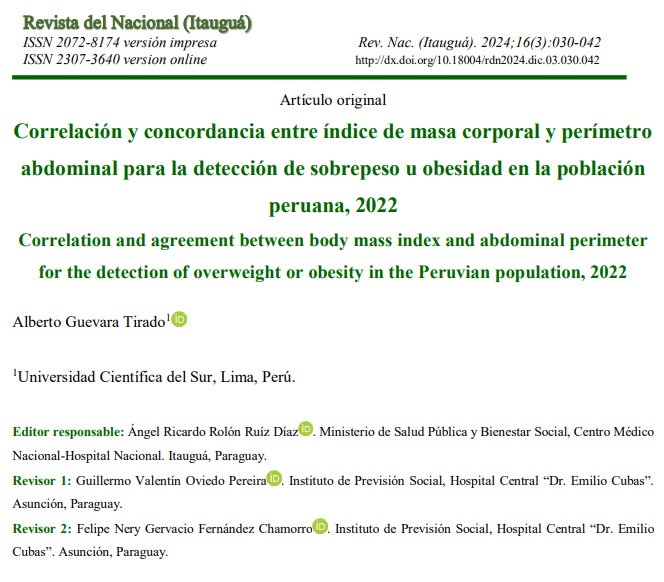Correlation and agreement between body mass index and abdominal perimeter for the detection of overwei 2022
Main Article Content
Abstract
Introduction: body mass index and abdominal perimeter are anthropometric measurements that could be concordant in the Peruvian population for screening for overweight or obesity.
Objective: to analyze the correlation and agreement between body mass index and abdominal circumference tests for the detection of overweight or obesity in Peruvian adults.
Methodology: observational, analytical and cross-sectional study based on data from the national demographic family health survey. The population was 28,960 adults. The variables were: body mass index and abdominal perimeter. Cramer's V test, student's t, Spearman's correlation and Cohen's kappa were used.
Results: there was a strong association between body mass index and abdominal perimeter in women (V=0.701), moderate in men (V=0.632). In Cohen's kappa test, both variables agreed substantially in women (kappa=0.677) and moderately in men (kappa=0.580). Using the Odds Ratio, women with a high body mass index had a 97.22 times greater probability of having a high abdomina
circumference, while in men with a high body mass index it was 110.76 times greater. The Spearman correlation was very high and positive in both sexes
Conclusions: abdominal circumference and body mass index are significantly associated and correlated in Peruvian adults; they presented substantial agreement in women and moderate agreement in men. It is suggested to prioritize the use of the abdominal perimeter, because it distinguishes overweight or obesity according to sex, optimizing it by determining a cut-off point adjusted to the Peruvian population.
Article Details

This work is licensed under a Creative Commons Attribution 4.0 International License.
References
Borga M, West J, Bell JD, Harvey NC, Romu T, Heymsfield SB, et al. Advanced body composition assessment: from body mass index to body composition profiling. J Investig Med [Internet]. 2018;66(5):1–9. doi: 10.1136/jim-2018-000722
Misra A, Dhurandhar NV. Current formula for calculating body mass index is applicable to Asian populations. Nutr Diabetes [Internet]. 2019 [citado 1 de octubre de 2023];9(1):1–2. Disponible en: https://www.nature.com/articles/s41387-018-0070-9
Gutin I. In BMI we trust: reframing the body mass index as a measure of health. Soc Theory Health [Internet]. 2018;16(3):256–71. doi: 10.1057/s41285-017-0055-0
Bauce G. Índice de masa corporal, peso ideal y porcentaje de grasa corporal en personas de diferentes grupos etarios. Rev Digit Postgrado [Internet]. 2022 [citado 1 de octubre de 2023];11(1):e331–e331. Disponible en: http://saber.ucv.ve/ojs/index.php/rev_dp/article/view/22824
Parente EB. Is body mass index still a good tool for obesity evaluation? Arch Endocrinol Metab [Internet]. 2016 [citado 2 de octubre de 2023];60(6):507–9. Disponible en: https://www.scielo.br/j/aem/a/wc7tPHkdM8mGhfZSSkhfNph/?lang=en
Xia JY, Lloyd-Jones DM, Khan SS. Association of body mass index with mortality in cardiovascular disease: new insights into the obesity paradox from multiple perspectives. Trends Cardiovasc Med [Internet]. 2019;29(4):220–5. Disponible en: https://www.sciencedirect.com/science/article/pii/S1050173818301695
Al-Shaar L, Li Y, Rimm EB, Manson JE, Rosner B, Hu FB, et al. Body mass index and mortality among adults with incident myocardial infarction. Am J Epidemiol [Internet]. 2021 [citado 2 de octubre de 2023];190(10):2019–28. Disponible en: https://pubmed.ncbi.nlm.nih.gov/33907796/
Weir CB, Jan A. BMI Classification percentile and cut off points. 2023 [citado 2 de octubre de 2023]. In: StatPearls. Treasure Island (FL): StatPearls Publishing; 2024. Disponible en: https://pubmed.ncbi.nlm.nih.gov/31082114/
Gensthaler L, Felsenreich DM, Jedamzik J, Eichelter J, Nixdorf L, Bichler C, et al. Trends of overweight and obesity in male adolescents: Prevalence, socioeconomic status, and impact on cardiovascular risk in a central European country. Obes Surg [Internet]. 2022 [citado 2 de octubre de 2023];32(4):1024–33. doi: 10.1007/s11695-021-05867-z
Mathus-Vliegen EMH, Basdevant A, Finer N, Hainer V, Hauner H, Micic D, et al. Prevalence, pathophysiology, health consequences and treatment options of obesity in the elderly: A guideline. Obes Facts [Internet]. 2012 [citado 2 de octubre de 2023];5(3):460–83. doi: 10.1159/000341193.
Tarqui-Mamani C, Alvarez-Dongo D, Espinoza-Oriundo PL, Sanchez-Abanto JR. Análisis de la tendencia del sobrepeso y obesidad en la población peruana. Rev Esp Nutr Humana Diet [Internet]. 2017 [citado 2 de octubre de 2023];21(2):137–47. Disponible en: https://scielo.isciii.es/scielo.php?script=sci_arttext&pid=S2174-51452017000200006

